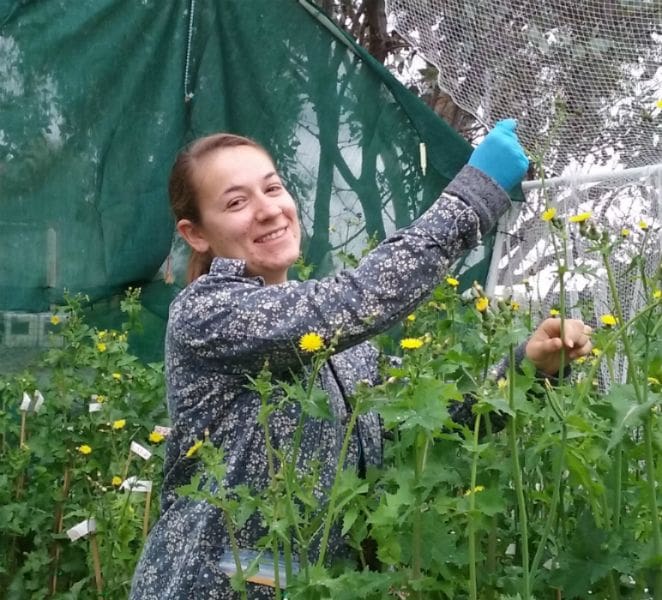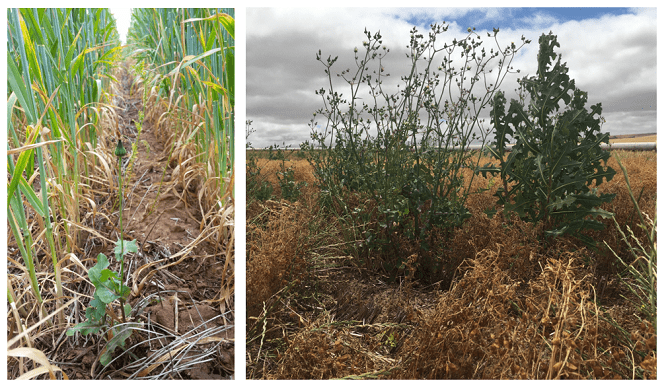Ask a WeedSmart Expert
A NEW IMI-tolerant lentil variety, PBA Kelpie XT, has just been released. PBA Kelpie XT is the fifth lentil variety released with tolerance to Group B herbicides, imazamox and imazapyr, along with one IMI-tolerant faba bean.

University of Adelaide weeds researcher and PhD candidate, Alicia Merriam, says screening has shown resistance to IMI herbicides in over 75 per cent of populations of both weeds collected in random weed surveys in South Australia.
University of Adelaide weeds researcher and PhD candidate, Alicia Merriam, says resistance to the IMI herbicides and other Group B chemistry, particularly the sulfonylureas (SU), is making control of some broadleaf weeds very difficult.
“IMI-tolerant lentils have been very popular with growers and have increased the weed control options in this important crop, but resistance in sowthistle and prickly lettuce is very widespread in the southern region,” she said.
“Screening has shown resistance to IMI herbicides in over 75 per cent of populations of both weeds.”
With investment from GRDC and an Australian Government Research Training Program Scholarship, Ms Merriam conducted a trial at two sites in South Australia to investigate options to implement the best practice recommendation for lentils – to control weeds in the preceding wheat crop and again at sowing or crop emergence in the lentils.
Both sowthistle and prickly lettuce are renowned for their prolific seed production when growing in non-competitive situations and wind dispersal of seed enables recruitment of resistance from crop borders, and far beyond. Consequently, eradication is not a realistic proposition.
“Sequencing the gene that controls resistance to Group B herbicides has uncovered a large variety of different mutations in these species across the Mid North and Yorke Peninsula in SA,” she said.
“Most mutations of this type cause SU resistance, but some cause IMI resistance and the effect can vary between weed species. Crucially, we found all these mutations within a single grower paddock, which shows that they are widely distributed.
“Crop rotation and increased crop competition are essential components of the WeedSmart Big 6 to help run down the seed bank and suppress seed production by all means available.
“Herbicide tolerance in pulse crops is a useful tool when coupled with strong competition and other herbicide options in as many crops as possible in the rotation.”
What is the current resistance status of sowthistle and prickly lettuce in the southern region?
In brief: Widespread resistance to Group B SU and IMI chemistry exists in both these broadleaf weeds.
The details: In surveys conducted in the Mid North and Yorke Peninsula regions the percentage of SU-resistant populations of prickly lettuce increased from 66 per cent in 1999 to 82 per cent in 2004 and 100 per cent in 2019. The populations screened in the 2019 survey were all resistant to Group B IMI chemistry.
Sowthistle surveys in the Mid North and Yorke Peninsula have found SU resistance in 89 per cent of populations and IMI resistance in 76 per cent of populations. Surveys also show that Group B resistance in sowthistle is very common across the rest of the southern cropping region.

In less competitive situations (right) sowthistle and prickly lettuce produce vast quantities of seed whereas in competitive situations (left) seed production is considerably reduced.
Did crop competition or herbicide treatments affect weed seed production in the wheat phase or weed numbers in the following crop?
In brief: The herbicide treatments used in the 2018 wheat crop had an impact on the sowthistle population in the next crop, but had little effect on prickly lettuce. Crop competition treatments did not reduce weed density in the following growing season.
The details: The weed populations at both sites were confirmed resistant to Group B herbicides but susceptible to glyphosate. The three in-crop treatments were 1. no in-crop herbicide, 2. ‘conventional’ herbicide application of metsulfuron-methyl (Ally) + MCPA and 3. ‘proactive’ herbicide application of bromoxynil + picolinafen + MCPA (Flight EC). Two levels of crop competition (seeding rate 60 and 90 kg/ha) were also applied.
In the 2018 wheat crop the proactive treatment gave the best control of sowthistle in that crop and this resulted in a reduction in numbers in the 2019 crop. Although the conventional treatment provided some weed control benefit in the 2018 crop, the benefit did not flow on to the next crop, probably because the sowthistle population was resistant to the residual action of the metsulfuron-methyl component of the conventional treatment.
The herbicide treatments both reduced prickly lettuce density better than the untreated option but there was no additional benefit from the more expensive proactive treatment in either the year of application or the following crop.
Crop competition is a well-established practice for reducing weed seed production, so it was surprising to find that increased crop competition did not reduce weed numbers in the following year. This could be due to conditions in the year of the trial and the mobility of seed of these species.
What’s the take-home message for using herbicide tolerant lentils in the rotation?
In brief: Herbicide tolerant crops are an important tool but must complement a diverse arsenal of weed control tactics. Short rotations are a very risky option and will lead to yield-reducing numbers of these prolific seeding weeds.
The details: Sowthistle and prickly lettuce can be expected to become increasingly difficult to control in the lentil phase. Neither crop competition nor proactive herbicide regimes alone are likely to provide sufficient downward pressure on these weeds in a short rotation. Building in a longer break away from lentils is likely to be a more effective strategy.
The number of different resistance mutations found in the cropping regions of the Mid North and Yorke Peninsula show that Group B resistance is widespread, and here to stay. This highlights the importance of diversity in crop and herbicide groups rotations, including the strategic use of herbicide tolerant crops.
The new Group G herbicide Reflex, with planned registration for IBS (knife point press wheel) application in lentils, will also be a welcome addition to improve weed control options in this crop.
Source: WeedSmart
…………………………………………………
How to ask a WeedSmart question
Ask your questions about herbicide tolerant crops on the WeedSmart Innovations Facebook page WeedSmartAU, Twitter @WeedSmartAU or the WeedSmart website www.weedsmart.org.au/category/ask-an-expert/
‘WeedSmart’ is an industry-led initiative that aims to enhance on-farm practices and promote the long term, sustainable use of herbicides in Australian agriculture.

HAVE YOUR SAY